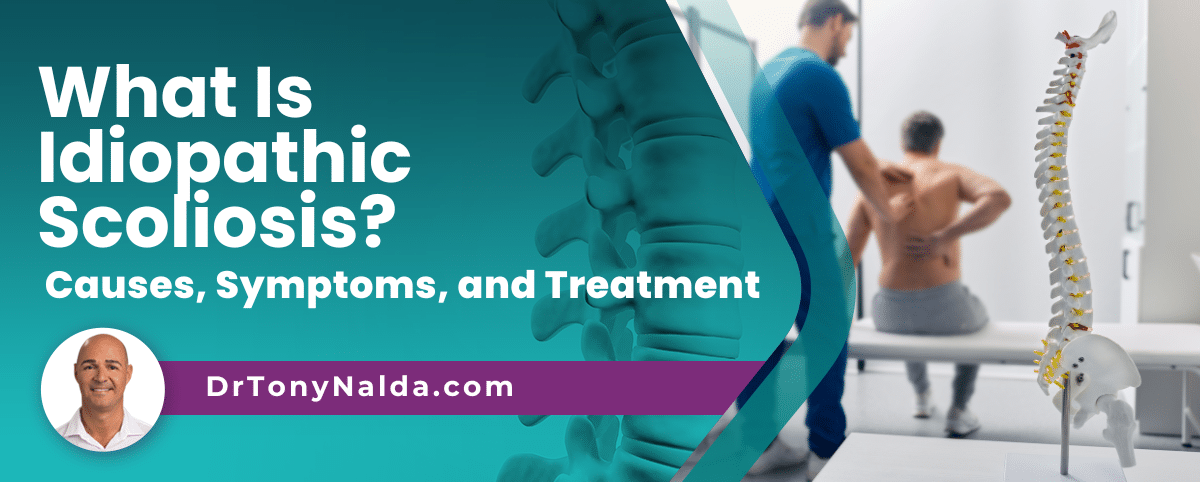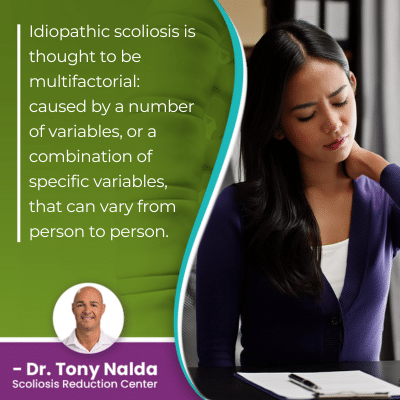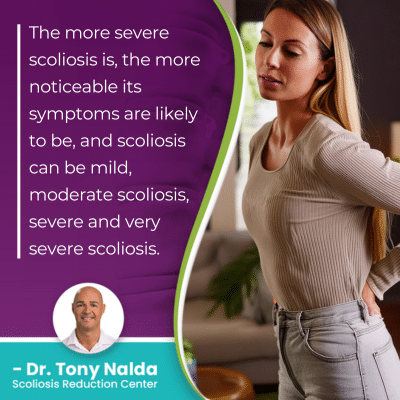What Is Idiopathic Scoliosis? Causes, Symptoms, and Treatment

While the cause of idiopathic scoliosis is unknown, we do fully understand its effects and treatment needs; in fact, regardless of a condition's cause, the most important decision to be made following a diagnosis is how to respond with treatment.
Idiopathic scoliosis accounts for approximately 80 percent of known diagnosed cases, and idiopathic means cause unknown. The cause of idiopathic scoliosis is thought to be multifactorial, rather than being associated with a single-known cause.
When it comes to understanding scoliosis, it's a highly-variable condition with different severity levels, types, and treatment needs.
Table of Contents
Idiopathic Scoliosis: What is it?
Current estimates have close to seven million people living with scoliosis in the United States alone, and idiopathic scoliosis is not clearly associated with a single-known cause.
Scoliosis causes the development of an unnatural sideways bending and twisting spinal curvature, and despite scoliosis being around since ancient times, there is still a lot we don't know about the condition.
 Idiopathic scoliosis is thought to be multifactorial: caused by a number of variables, or a combination of specific variables, that can vary from person to person.
Idiopathic scoliosis is thought to be multifactorial: caused by a number of variables, or a combination of specific variables, that can vary from person to person.
Scoliosis affects all ages; babies are born with congenital scoliosis, infantile idiopathic scoliosis affects infants between the ages of 6 months and 3 years old, juvenile idiopathic scoliosis, adolescent idiopathic scoliosis, and adult scoliosis is diagnosed once skeletal maturity has been reached.
Adolescent idiopathic scoliosis patients are the most at risk for rapid-phase progression because of the growth spurts of puberty that can make abnormal spinal curvatures progress quickly.
As approximately 80 percent of known causes are idiopathic, the remaining 20 percent of known cases are associated with known causes and are considered atypical.
Scoliosis with Known Causes
Neuromuscular scoliosis, congenital scoliosis, and degenerative scoliosis make up the remaining 20 percent and have known causes, unlike idiopathic scoliosis.
Neuromuscular scoliosis patients can be among my most difficult to treat because they are atypical cases that tend to be severe; the scoliosis develops as a secondary complication of a larger neuromuscular condition, such as cerebral palsy, muscular dystrophy, or spinal bifida.
Neuromuscular scoliosis is caused by a disconnect between the brain, the connective tissues, and the muscles that support the spine.
In cases of neuromuscular scoliosis, the larger neuromuscular condition has to be the focus of treatment, which complicates the treatment process.
Congenital scoliosis is caused by a malformed spine that develops in utero so babies are born with the condition, and it's a rare form, affecting approximately one in 10,000.
Degenerative scoliosis is caused by natural age-related spinal degeneration and the cumulative effect of certain lifestyle choices: carrying excess weight, low activity levels, chronic poor posture, etc.
Symptoms of Idiopathic Scoliosis
The most prevalent type of scoliosis overall is adolescent idiopathic scoliosis, diagnosed between the ages of 10 and 18.
Adolescent idiopathic scoliosis is progressive, like all types of scoliosis. Progressive conditions have it in their nature to become more severe over time.
The more severe scoliosis is, the more noticeable its symptoms are likely to be, and scoliosis can be mild, moderate scoliosis, severe and very severe scoliosis.
Symptoms of scoliosis can vary from person to person based on a number of patient/condition variables.
The main symptom of childhood scoliosis is postural deviation caused by the condition's uneven forces disrupting the body's overall symmetry.
Postural changes can include:
- Uneven shoulders
- Uneven shoulder blades
- Development of a rib cage arch
- Uneven hips
- Arms and legs that hang at different lengths
As the posture changes and the body's center of gravity shifts further, changes to movement are also common: balance, coordination, and gait can also be affected.
It can be hard for adolescents to be diagnosed with scoliosis, a progressive condition that can make them look and walk differently, but with proactive treatment, there are fewer limits to what can be achieved with treatment.
A focus of adolescent idiopathic scoliosis treatment is on counteracting its progressive nature, and this means reducing the curve and holding it there despite the constant progressive trigger of growth.
Idiopathic Scoliosis is Progressive
Idiopathic scoliosis is progressive, so its nature is to get worse over time, making it more complex to treat.
As a progressive condition, virtually all cases are going to progress at some point, and as progression occurs, conditions are becoming more severe, and the spine is becoming less responsive to nonsurgical treatment.
The spine gets increasingly rigid alongside progression, and this can make it less responsive to treatment, and make it difficult for patients to perform key therapeutic exercises as part of treatment, so the earlier treatment is started, the better.
We don't know what causes the initial onset of adolescent idiopathic scoliosis, but we know it's growth that makes it progress, which is why childhood scoliosis should always be taken seriously and treated proactively; as a child grows, scoliosis can get worse and potentially require surgical correction in the future.
The reality, however, is that many patients with scoliosis don't need surgery, particularly with early detection, intervention, and a proactive conservative treatment approach.
Conservative Treatment Options
 When it comes time to treat scoliosis, this is the most important decision to be made; I remind patients that not knowing what caused the condition to develop initially won't change the course of treatment, or its efficacy.
When it comes time to treat scoliosis, this is the most important decision to be made; I remind patients that not knowing what caused the condition to develop initially won't change the course of treatment, or its efficacy.
While there are never treatment guarantees, scoliosis that's diagnosed early and treated early shows better results, particularly when it comes to a proactive conservative treatment approach.
When treatment is started early in a condition's progressive line, it's simpler to treat; curves are smaller and significant progression hasn't yet occurred.
In most cases, it's better to proactively work towards preventing progression and increasing condition effects than it is to attempt to reverse them once they're established.
When treatment is proactive, it can work towards preventing progression, and conservative chiropractic-centered treatment is integrative, combining multiple different types of treatment so conditions can be impacted on every level.
Chiropractic Care and Adjustments
While the complex nature of scoliosis is beyond the scope of general chiropractic care, scoliosis-specific chiropractors know the spine, and they know scoliosis, and when combined with other types of treatment, the spine can be responsive.
Chiropractic care is applied to work towards adjusting the position of the curve's most-tilted vertebrae back into alignment with the rest of the spine, restoring as much of its healthy curves as possible.
A curvature reduction can impact scoliosis on a structural level and improve the spine's biomechanics.
Physical Therapy
Physical therapy and scoliosis exercises can help prepare the spine and its surroundings for treatment, and they can also help increase core muscle strength so the spine's surrounding muscles can optimally support and stabilize it.
Physical therapy can also help improve posture, balance muscles, and activate certain areas of the brain for improved brain-body communication.
Corrective Bracing
Corrective bracing can be particularly effective on growing spines so is a regular facet of childhood scoliosis treatment.
The ultra-corrective ScoliBrace can help augment corrective treatment results by pushing the spine into a straighter alignment and healthier position.
Further rehabilitation of the spine can involve continued chiropractic care and scoliosis exercises to perform from home to further heal and stabilize the spine.
Conclusion
Idiopathic scoliosis is the leading spinal condition among school-aged children, and as a progressive condition triggered by growth, there are numerous treatment benefits associated with early diagnosis; however, the benefits of early detection are only available to those whose diagnosis is met with a proactive treatment plan.
Being proactive with treatment means working towards preventing progression, rather than reacting to it if/when it occurs; traditional scoliosis surgery does just that.
Spinal fusion surgery can straighten a bent spine, but it can come at the cost of the spine's overall health, strength, and function, and again, many cases of scoliosis don't require surgery.
As such a highly-prevalent spinal condition, scoliosis awareness is important as it can mean knowing the condition's early signs to watch for: leading to assessment, diagnosis, and treatment.
The earliest signs of scoliosis to watch for in children include uneven shoulders and hips, and in adults, the most noticeable symptom of scoliosis is usually pain; this can involve muscle pain, back pain, and pain that radiates into the extremities due to nerve compression.
So idiopathic scoliosis is a progressive spinal condition that causes the spine to bend and twist unnaturally, its cause is unknown, symptoms include postural changes and pain, and treatment options include chiropractic care, physical therapy, and rehabilitation.
The best time to start treatment for an unnatural curvature of the spine is always now; when it comes to progressive conditions like scoliosis, the sooner treatment is started, the better.
Dr. Tony Nalda
DOCTOR OF CHIROPRACTIC
After receiving an undergraduate degree in psychology and his Doctorate of Chiropractic from Life University, Dr. Nalda settled in Celebration, Florida and proceeded to build one of Central Florida’s most successful chiropractic clinics.
His experience with patients suffering from scoliosis, and the confusion and frustration they faced, led him to seek a specialty in scoliosis care. In 2006 he completed his Intensive Care Certification from CLEAR Institute, a leading scoliosis educational and certification center.
About Dr. Tony Nalda
 Ready to explore scoliosis treatment? Contact Us Now
Ready to explore scoliosis treatment? Contact Us Now





